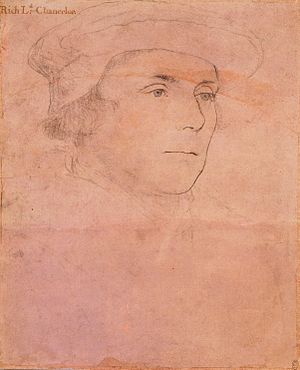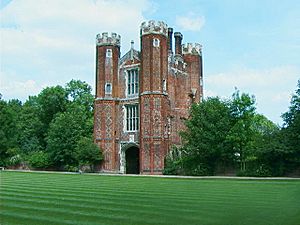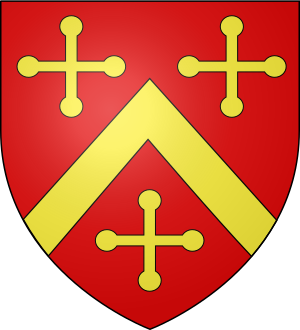Richard Rich, 1st Baron Rich facts for kids
Quick facts for kids
The Lord Rich
|
|
|---|---|

Portrait by Hans Holbein the Younger
|
|
| Speaker of the House of Commons | |
| In office 9 June 1536 – 18 July 1536 |
|
| Preceded by | Humphrey Wingfield |
| Succeeded by | Nicholas Hare |
| Lord Chancellor | |
| In office 1547–1552 |
|
| Preceded by | The Lord St John |
| Succeeded by | Thomas Goodrich |
| Personal details | |
| Born | July 1496 |
| Died | 12 June 1567 (aged 70) Rochford, Essex |
| Resting place | Felsted church, Essex |
| Occupation | Lord Chancellor of England |
Richard Rich, 1st Baron Rich (born around July 1496 – died 12 June 1567), was an important English lawyer and politician. He served as Lord Chancellor, a very high legal position, during the reign of King Edward VI of England. He held this role from 1547 until 1552.
Richard Rich is also known for founding Felsted School in Essex in 1564. He gained a lot of wealth and land during the time of the Dissolution of the Monasteries. This was when King Henry VIII of England closed down many monasteries and took their property. Rich played a part in the trials of famous figures like Thomas More and John Fisher.
Contents
Early Life and Beginnings
Richard Rich was likely born around 1496. Some records suggest he was born in London, while others point to Basingstoke in Hampshire. Not much is known about his very early life.
He began his legal career by studying law at the Middle Temple in London around 1516. By 1529, he became a Member of Parliament (MP) for Colchester. This was an important step in his political journey. As his career grew, he took on various legal jobs.
Rising in Power
In 1533, Richard Rich was knighted, meaning he became "Sir Richard Rich." He also became the Solicitor General for England and Wales. This job meant he was a chief legal advisor to the King. In this role, he helped King Henry VIII carry out his policies, especially the Act of Supremacy. This act made the King, not the Pope, the head of the Church in England.
Rich was involved in the trials of important people who disagreed with the King's new religious changes. These included Thomas More and John Fisher. He also played a part in the downfall of Thomas Cromwell, another powerful figure in Henry VIII's government.
In 1536, Rich traveled to Kimbolton Castle. There, he took an inventory of the belongings of Catherine of Aragon, King Henry VIII's first wife.
Becoming Chancellor
On April 19, 1536, Rich became the Chancellor of the Court of Augmentations. This court was set up to manage the money and lands that came from closing down the monasteries. Richard Rich gained a lot of land and wealth from this process. For example, he acquired Leez Priory and many other estates in Essex. He also took over the property of the Priory of St Bartholomew-the-Great in London.
In the same year, he became the Speaker of the House of Commons. In this role, he supported the King's policies in Parliament. Even though he helped close monasteries and prosecute people, his personal religious beliefs were still Catholic.
Rich was also involved in the events surrounding Anne Askew. She was a Protestant woman who faced severe questioning at the Tower of London.
Baron Rich and Later Years

When King Henry VIII died, Richard Rich was named as an assistant to carry out the King's will. He received more land as a reward. On February 26, 1547, he was given the title of Baron Rich of Leez. This made him a nobleman.
The next month, he became Lord Chancellor, one of the most powerful positions in England. He supported Edward Seymour, 1st Duke of Somerset, who was the Lord Protector for the young King Edward VI. Rich helped with Church reforms and the prosecution of Thomas Seymour, the Lord Protector's brother. He resigned from his role as Lord Chancellor in January 1552.

Rich was involved in the legal cases against bishops Stephen Gardiner and Edmund Bonner. He also played a part in the difficult treatment of the future Mary I of England. However, when Mary became Queen, she did not hold a grudge against him. He actively helped restore the old Catholic religion in Essex during her reign.
Under Queen Elizabeth I of England, he served on a committee looking into land grants made during Mary's reign. In 1566, he was asked for advice on the Queen's marriage. He passed away in Rochford, Essex, on June 12, 1567. He was buried in Felsted church.
In Queen Mary's time, he set up a special fund for religious services in Felsted church. In 1564, these donations were used to establish Felsted School. This school was founded to teach Latin, Greek, and religious studies, especially for children from his own estates. His family continued to support the school until 1851.
Family and Legacy
Richard Rich had a large family. He and his wife, Elizabeth Jenks, had 15 children. His descendants became a powerful family in England for three centuries. They gained several noble titles and married into many other important families.
His eldest son, Robert, became the second Baron Rich. Robert supported the Protestant Reformation. One of Richard Rich's grandsons, Robert Rich, became the first Earl of Warwick in 1618.
Richard Rich also had an illegitimate son, also named Richard, whom he recognized in his will. This son's descendants included Sir Nathaniel Rich, a merchant, and Nathaniel Rich, a colonel during the English Civil War.
Since the 1500s, Richard Rich has had a reputation for being dishonest and tricky. The historian Hugh Trevor-Roper once said that "nobody has ever spoken a good word" about him.
Richard Rich in Arts and Media
Richard Rich has been shown in many plays, films, and books.
- In the play A Man for All Seasons by Robert Bolt, he is a supporting character who becomes corrupt. In the 1966 film version, John Hurt played him. The film suggests he lied to become Attorney-General for Wales.
- He appears as a character in C. J. Sansom's Shardlake series of historical mystery novels. In these books, he is shown as a cruel villain who will do anything to gain power and property.
- Rod Hallett played Richard Rich in the TV series The Tudors.
- He is also a character in Hilary Mantel's novels about Thomas Cromwell: Wolf Hall, Bring Up the Bodies, and The Mirror and the Light. Bryan Dick played him in the BBC TV show Wolf Hall.
Images for kids






